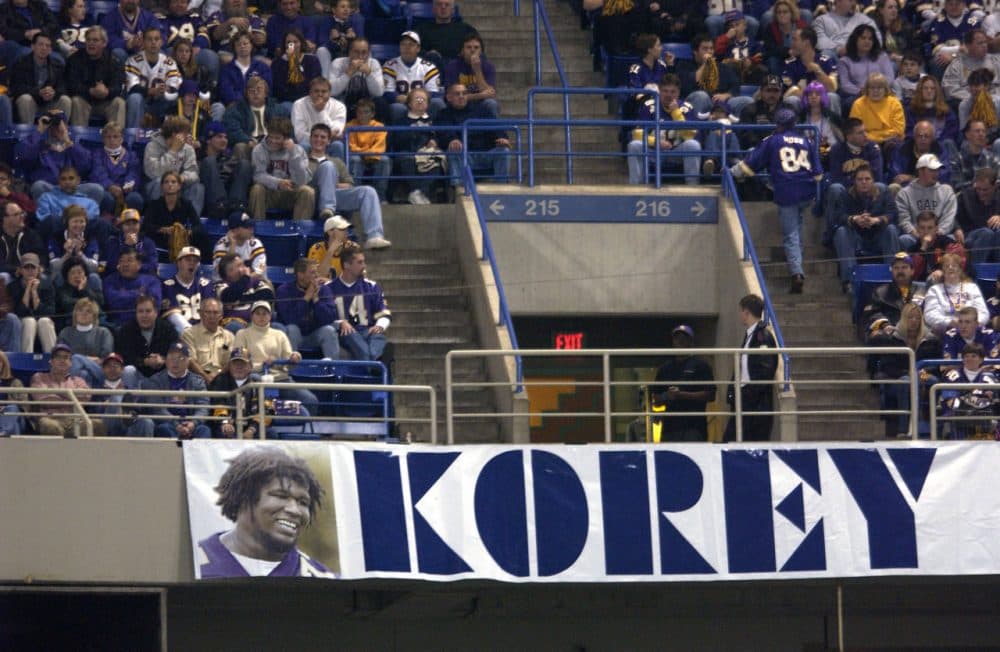Advertisement
Protecting High School Athletes From Preventable Deaths
Resume
Doug Casa, chief operating officer of the Korey Stringer Institute, says the highest number of sports-related deaths in the U.S. are among the 7 million high school athletes.
Casa, along with the National Athletic Trainers' Association, is asking all 50 states to adopt safety procedures to safeguard athletes. Casa joined Bill Littlefield to discuss his efforts to make high school sports safer.
BL: Doug, how many athletes are we talking about in a given year?
DC: In a given year, if we just focus on high school, you usually see between 20 and 30 deaths. We're also very focused on what we call "catastrophic injuries" that may not lead to death. And those will number in the hundreds.
BL: You focus your study on four causes of death: sudden cardiac arrest, head injuries, heat stroke and complications from the sickle cell trait. How did you narrow it down to just those four?
[sidebar title="Testing High School Athletes For Steroids" width="630" align="right"]"Kids ... find the tests pretty easy to beat," says the founder of a group that aims to prevent steroid use.[/sidebar]DC: It's a good question. I mean, the research has shown that those four causes of death actually are about 90 percent of all the deaths that we see in high school and college sports. So it's not to say there aren't other things that could be dangerous to an athlete, like lightning strikes or something called hyponatremia or asthma.
But those four that I mentioned, all four of these conditions can be prevented. And in the case of heat stroke, for instance, death is 100 percent preventable if treated properly. And in the case of cardiac conditions, if an AED [automated external defibrillator] is placed on within a minute, they're 90 percent preventable.
BL: In 2013, I understand that along with the National Athletic Trainers' Association, you recommended that all 50 states adopt guidelines to protect athletes from sudden death. But in 2015, only 22 percent of states have done that. Why is it so difficult to get everybody on the same page when it comes to something so basic as player safety?
I've been an expert witness on 35 cases where deaths have happened in sport ... and in almost all the cases, the death was preventable with relatively simple, simple policies and procedures.
Doug Casa, Korey Stringer Institute
I really think the last three-to-five years have been just a total, monumental shift in the thought process, and we've seen a lot of substantial changes. As an example, with heat acclimatization, in 2011 we had zero states that met the minimum guidelines for heat acclimatization, which is kind of the key step to prevent heat stroke deaths. And now we're at 14 states. And it might not seem like a lot, but of those 14 states, 10 of them are in the Southeast, and we still have not had a heat stroke death in any of those 14 states that have followed those policies. So that's powerful ammunition for those other states to move forward and adapt some of these policies.
BL: I find it hard to understand how something so commonsensical as "Hey, let's have some acclimatizing to heat conditions" could ever be controversial anywhere.
We don't want to stop until we have 50 states, although my wife keeps convincing me we don't need Alaska for heat acclimatization.
Doug Casa, Korey Stringer Institute
So I do agree with you, it's very common sense, it's very simple changes and the amazing thing is it costs so money at all. So when we usually get a chance to sit down and meet with them individually, most make progressive changes. Fourteen states meet the minimum standards, but, to give credit, another 20 have made substantial changes in the right direction.
BL: You know, Doug, I haven't known you for very long but I can tell you are the ultimate "glass half-full" kind of guy if you're talking about 14 states are on board, and you're talking about progress.
DC: Well, I guess my way of looking at it is 90 percent of all heat stroke deaths in America happen in concentrated states in the Southeast region of the country. So probably saving three or four kids lives every summer just by the states we've gotten on board — so that makes me feel pretty good for those families. But yeah, we don't want to stop until we have 50 states, although my wife keeps convincing me we don't need Alaska for heat acclimatization.
But I mean that's just one example. There's a lot of really simple things we can do to keep kids safe. I mean, AEDs is a great example. It's only $1,000 for an athletic department to have one nearby. Cardiac's the leading cause of death in sport in America and to have an AED there is almost a foolproof way of saving someone's life. It's really a pretty small cost when you think of the benefit.
BL: Especially when you're thinking in terms of a $60 million high school football stadium.
DC: That, or when you think about the lawsuits that emanate when deaths do occur that are preventable. I've been an expert witness on 35 cases where deaths have happened in sport, especially at the high school level. And in almost all the cases, the death was preventable with relatively simple, simple policies and procedures that would have protected that kid that passed away.
This segment aired on March 28, 2015.